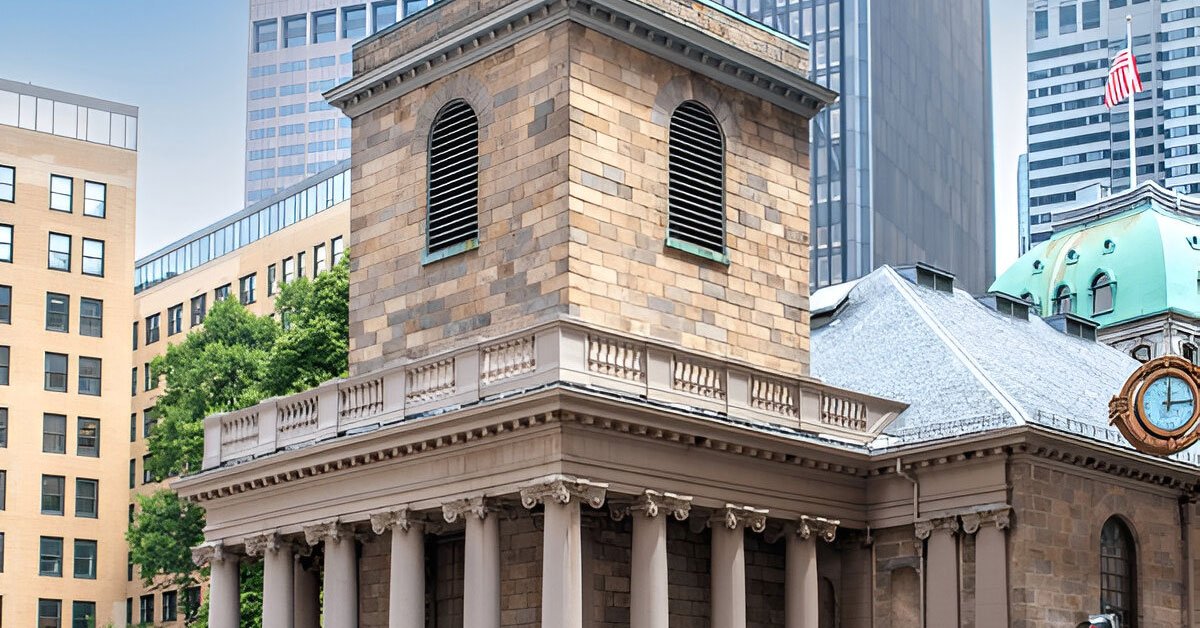Physical Address
304 North Cardinal St.
Dorchester Center, MA 02124
Physical Address
304 North Cardinal St.
Dorchester Center, MA 02124

Nestled in the heart of Boston, King’s Chapel is more than just a historic building—it’s a portal into the city’s storied past. With its striking Georgian architecture and fascinating history, this iconic landmark attracts travelers from across the globe. Whether you’re a history buff, an architecture enthusiast, or a casual visitor, King’s Chapel offers a unique glimpse into colonial America. Let’s dive into everything you need to know about this remarkable site.
King’s Chapel is located at 58 Tremont Street in downtown Boston. It is perfectly positioned along the famous Freedom Trail, making it a convenient stop for those exploring Boston’s revolutionary landmarks. The Chapel sits right across from Boston Common and next to the Granary Burying Ground, two of the city’s most visited attractions.
The central location of King’s Chapel makes it incredibly accessible for all visitors, whether walking the city streets or relying on public transport.
King’s Chapel has a fascinating and complex history reflects Boston’s transition from a Puritan stronghold to a diverse city embracing freedom of religion. It was originally established in 1686 as the first Anglican church in Puritan Boston. Because Puritans dominated the city at the time, they refused to sell land to construct a non-Puritan church. As a result, King’s Chapel was built on land that had been taken from the city’s first public burying ground, now known as the King’s Chapel Burying Ground.
The current structure replaced the wooden church in 1754, a stunning example of Georgian architecture. Built using Quincy granite, it became a model for early American ecclesiastical architecture. The designer, Peter Harrison, is often called America’s first architect.
After the American Revolution, King’s Chapel transformed. In 1785, its congregation transitioned from Anglicanism to Unitarianism, making it one of the first Unitarian churches in the United States. Despite this shift, the Chapel retained its royal name, a nod to its historic origins.
Today, King’s Chapel is a National Historic Landmark and continues to be a place of worship and community, offering visitors a glimpse into Boston’s colonial and religious past.
Visiting King’s Chapel is a sensory experience, offering rich historical narratives, architectural beauty, and a serene atmosphere. Here’s a guide to the highlights:
Step inside, and the grand simplicity of the interior will immediately strike you. The high, arched windows let in natural light, while the wooden box pews—original to the 18th century—add a sense of intimacy and charm. Don’t miss the impressive pulpit, which dates back to 1717, making it the oldest in continuous use in the United States.
Adjacent to the Chapel, this cemetery predates the church itself and is the oldest burying ground in Boston, established in 1630. Many notable figures are buried here, including John Winthrop, the first governor of Massachusetts, and Mary Chilton, a Mayflower passenger. Strolling through the grounds feels like stepping into a living museum.
The Chapel houses an exquisite organ that was built in 1756in London. While the original pipes are no longer in use, the organ’s modern counterpart retains its historical character. Catch one of the organ performances to hear this magnificent instrument in action.
Join one of the Chapel’s tours to delve deeper into its history. The “Bells and Bones Tour” is particularly popular, offering access to the crypts beneath the Chapel and the historic bell tower. The current bell was cast by Paul Revere in 1816, making it a must-see for history enthusiasts.
King’s Chapel regularly hosts events, from concerts to lectures and special holiday services. Visiting during Christmas or Easter offers an opportunity to witness traditions that date back centuries.
A visit to King’s Chapel is both informative and inspirational, making it a must-see for anyone interested in Boston’s cultural heritage.
The area surrounding King’s Chapel is rich in history and brimming with attractions. Here are some must-visit spots within walking distance:
Just a stone’s throw away, this sprawling public park is the oldest in America, established in 1634. It’s perfect for a leisurely stroll, a picnic, or even ice skating in the winter.
Located steps away from King’s Chapel, this cemetery is the resting place of many Revolutionary War heroes, including Paul Revere, Samuel Adams, and John Hancock.
Sitting atop Beacon Hill, the State House is a striking landmark with its golden dome. Guided tours are available to explore its historic halls.
This historic church played a pivotal role in the events leading up to the Boston Tea Party. Today, it serves as a museum dedicated to the American Revolution.
A short walk down Tremont Street, this bustling marketplace offers shopping, dining, and street performances. It’s a great spot to grab a bite and soak up the city’s vibrant atmosphere.
King’s Chapel is one of the 16 official stops on the Freedom Trail, a 2.5-mile route that takes visitors through Boston’s most historic sites. Take advantage of the trail to explore landmarks like the Old North Church and Bunker Hill Monument.
With so much to see and do nearby, a visit to King’s Chapel can easily become part of a full day of exploration in downtown Boston.
Visiting King’s Chapel Boston is a journey through time—a chance to stand where history happened and to reflect on the stories that shaped a nation. Whether you’re exploring its historic interior, wandering through its ancient burying ground, or taking in nearby attractions, this landmark offers an unforgettable experience for every traveler.